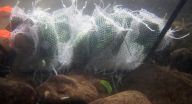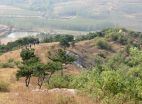(Press-News.org) Chemical changes that occur in tree leaves after being attacked by insects and mammals can impact nearby streams, which rely on fallen plant material as a food source, report scientists from the University of Chicago Department of Ecology and Evolution. The study, published March 17 in the journal Proceedings of the Royal Society B, shows how interactions between terrestrial and aquatic ecosystems are an essential part of understanding ecological responses to climate change.
Graduate student Sara Jackrel and Timothy Wootton, PhD, professor in the Department of Ecology and Evolution, simulated herbivory, or the activity of insects eating leaves, on red alder trees in a forest on the Olympic Peninsula in Washington state. Their research showed caterpillars ate fewer leaves from the stressed trees than those that were left alone. Leaves from these stressed trees also decomposed much more slowly when submerged in nearby streams, and further results suggest that the trees funneled a valuable nutritional resource away from the leaves as a defensive response to animal attacks.
"Terrestrial herbivory could have innumerable effects on leaf chemistry, and our simulation had a very strong effect in streams," said Jackrel, the study's lead author. "The tree's response to herbivory had a cascading effect across an ecosystem boundary, into another trophic level entirely. The important finding was making that indirect link from a terrestrial system into an aquatic system."
Plants generate many defensive responses to being attacked by insects and other animals. Some produce tannins and compounds that are toxic or taste bad to discourage herbivores from eating them. Others may even release chemicals that attract predators for the particular insect attacking the plant.
Insects and microbe decomposers that live in streams depend on a variety of nutritionally diverse leaf litter as a food sources. They play no direct role in the interactions between trees and their herbivores, but the new study shows how the composition of those leaves is shaped by their activity,
During her fieldwork, Jackrel mimicked the activity of caterpillars by systematically punching holes in the alder leaves with an office hole punch. She also painted the leaves with methyl jasmonate, a chemical that trees release under stress, to enhance the defensive response to the hole punches. Some trees were fertilized with phosphorus, while others were not.
Jackrel then buried packages of leaves and placed others underwater in a stream to test how quickly they decomposed in both soil and water. Caterpillars were also allowed to feed on treated and untreated leaves to test their preferences.
Leaves from trees that received both fertilizer and the herbivory treatment decomposed the most slowly. Caterpillars and aquatic insects ate fewer of these leaves than those from untreated trees as well.
Nitrogen levels were also much lower in the treated leaves. Insects value nitrogen as a nutrient, and the study results suggest that trees alter nitrogen levels to deter them from eating more leaves, perhaps by storing it the trunk or roots.
Understanding how trees' defensive responses to natural herbivores impact nearby streams will help scientists better predict the effects of climate change and other human activity like logging and agriculture.
"With climate change, insect communities are going to change," Jackrel said. "So understanding fundamentally how these communities naturally affect leaf chemistry, and how that might affect stream systems, is a critical reference to have. Then we can work to predict how climate change, along with other anthropogenic changes, might be affecting aquatic systems."
INFORMATION:
The study, "Cascading effects of induced terrestrial plant defences on aquatic and terrestrial ecosystem function," was supported by the National Science Foundation, the U.S. Department of Education, the University of Chicago Hinds Fund and an Olympic National Resources grant.
About the University of Chicago Medicine
The University of Chicago Medicine & Biological Sciences is one of the nation's leading academic medical institutions. It comprises the Pritzker School of Medicine, a top 10 medical school in the nation; the University of Chicago Biomedical Sciences Division; and the University of Chicago Medical Center, which recently opened the Center for Care and Discovery, a $700 million specialty medical facility. Twelve Nobel Prize winners in physiology or medicine have been affiliated with the University of Chicago Medicine.
Visit our research blog at sciencelife.uchospitals.edu and our newsroom at uchospitals.edu/news.
Twitter @UChicagoMed
Facebook.com/UChicagoMed
Longer duration of breastfeeding is linked with increased intelligence in adulthood, longer schooling, and higher adult earnings, a study following a group of almost 3500 newborns for 30 years published in The Lancet Global Health journal has found.
"The effect of breastfeeding on brain development and child intelligence is well established, but whether these effects persist into adulthood is less clear,"* explains lead author Dr Bernardo Lessa Horta from the Federal University of Pelotas in Brazil.
"Our study provides the first evidence that prolonged breastfeeding ...
Alteplase is a tissue plasminogen activator (tPA) that helps to disperse blood clots in a process called thrombolysis.
Most major stroke guidelines support use of alteplase up to 4.5 hours after stroke onset, but Dr Brian Alper and colleagues believe that current guidance is based on uncertain evidence and they call for urgent reconsideration of the available data to guide policy decisions.
The UK regulator, the Medicines and Healthcare Regulatory Agency (MHRA), is planning to analyse all relevant sources of evidence and reassess the balance of benefits and risks for ...
Previous research among young and older adults has suggested that the context in which drinking occurs may contribute to specific alcohol-related problems, such as aggression, risky sex, and drinking and driving. However, little is known about how young drinkers select drinking contexts. A longitudinal study of drinking patterns, and demographic and psychosocial characteristics associated with youth drinking in different contexts, has found that where youth drink alcohol varies by characteristics such as age, gender, drinking frequency, smoking, and deviant behaviors.
Results ...
Both the Diagnostic and Statistical Manual of Mental Disorders, 5th edition (DSM-5), and the International Statistical Classification of Diseases and Related Health Problems, 10th Edition (ICD-10) have established diagnostic criteria for alcohol use disorders (AUDs). While the DSM is widely used by clinicians, the U.S. Centers for Medicare and Medicaid Services has recently called for providers to bill for services using ICD-10 designations. Given the ramifications for who will and will be not eligible for treatment, this study compares the two diagnostic approaches, finding ...
A new study has examined genetic and environmental influences underlying alcohol use.
Results show that genetic effects on the amount of alcohol use appear to be greater in low socioeconomic-status (SES) conditions.
Shared environmental effects tended to increase in high-SES conditions, and non-shared environmental effects tended to decrease with SES.
Research on genetic and environmental influences underlying alcohol use has thus far failed to uncover specific causes, likely because genetic and environmental influences vary by context. A study of the moderating ...
DALLAS, March 17, 2015 -- Your heart health, which is optimal for most of us at birth, can decline substantially with unhealthy childhood behaviors, according to research in Circulation: Cardiovascular Quality and Outcomes, an American Heart Association journal.
"Our findings indicate that, in general, children start with pretty good blood pressure," said Donald M. Lloyd-Jones, M.D., Sc.M., senior author of the study and professor and chair of preventive medicine at the Northwestern University Feinberg School of Medicine in Chicago, Illinois. "But if they have a horrible ...
March 17, 2015 -- Female community health extension workers deployed to a remote rural community in northern Nigeria led to major and sustained increases in service utilization, including antenatal care and facility-based deliveries, according to latest research by Columbia University's Mailman School of Public. The research also showed that providing a rural residence allowance in addition to a standard salary helped recruit and retain female workers. Other key components to the program's success were posting workers in pairs to avoid isolation, ensuring supplies and transportation ...
Archaeologists from The Field Museum in Chicago, IL and Shandong University (Jinan, China) have investigated the historical processes leading up to China's political unification through the juxtaposition of macro- and micro-scale analysis. The study offers new perspectives on how human impacts of infrastructural investments, interactive technologies, social contracts, and ideologies that were implemented during the Qin and Han Dynasties and before have helped establish the rough spatial configuration of what is today China.
Why humans cooperate in large social groupings ...
The genome of a cell is under constant attack, suffering DNA damage that requires an army of repair mechanisms to keep the cell healthy and alive. Understanding the behavior of the enzymes defending these assaults helps determine how - and where - cancer gets its foothold and flourishes. New research published in an Advance Online Publication of Nature Structural & Molecular Biology shows that one of these enzymes - human DNA polymerase theta (POLQ) - may be a promising drug therapy target for inhibiting breast cancer.
"The human genome encodes more than 15 different ...
What's in store for the future of industrial bioprocessing for medical therapies, which involves the use of living organisms or cells to create drugs or other agents? Will the batch or continuous bioprocessing platform dominate biomanufacturing of human therapeutics down the road? Three pioneers in the field address these questions in an upcoming issue of Biotechnology and Bioengineering.
With batch bioprocessing, components are transferred as a batch from one holding vessel or processing equipment to the next, while with continuous bioprocessing, there is a continuous ...


